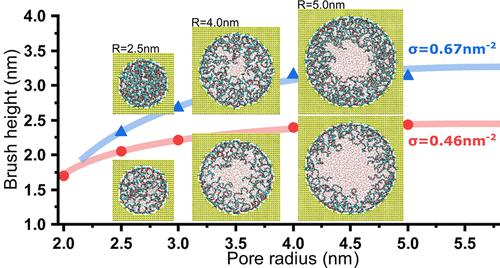当前位置:
X-MOL 学术
›
Macromolecules
›
论文详情
Our official English website, www.x-mol.net, welcomes your
feedback! (Note: you will need to create a separate account there.)
PEO-Grafted Gold Nanopore: Grafting Density, Chain Length, and Curvature Effects
Macromolecules ( IF 5.1 ) Pub Date : 2022-06-10 , DOI: 10.1021/acs.macromol.2c00323 Guang Chen 1 , Elena Dormidontova 1, 2
Macromolecules ( IF 5.1 ) Pub Date : 2022-06-10 , DOI: 10.1021/acs.macromol.2c00323 Guang Chen 1 , Elena Dormidontova 1, 2
Affiliation

|
Polymer-grafted nanopores are used in several nanotechnological applications which demand control of structural and hydration properties of the grafted polymers. By means of atomistic molecular dynamics simulations, we systematically investigate the chain length and grafting density effects on the conformation and hydration of poly(ethylene oxide) (PEO) grafted to gold nanopores of different radii. We find that if the pore size exceeds the polymer length, increasing the grafting density or chain length for a given pore results in conformational changes of the polymer from pancake-like shapes to well-hydrated overlapping mushrooms to a denser less hydrated polymer brush. We demonstrate that an increase of pore curvature results in considerable polymer crowding within the pore, which translates into an increase of the effective grafting density, σeff, which has to be taken into consideration when concave nanopores and planar and convex surfaces are compared. We show that for a given polymer grafting density and chain length, a decrease in the pore radius R results in an increased radial orientation, and for a low grafting density, there is a slight increase of the grafted layer height H until the polymer chains fill the pore (R ∼ H) and start folding near the pore surface, conforming into a cone-shape with a further brush height decrease until the high-density limit is reached. The properties of polymer-grafted nanopores, such as water exchange and gating capability, depend on the polymer conformation and hydration, which are strongly influenced by the polymer grafting density and differ for polymer-filled and open nanopores.
中文翻译:

PEO 接枝金纳米孔:接枝密度、链长和曲率效应
聚合物接枝纳米孔用于需要控制接枝聚合物的结构和水合性能的多种纳米技术应用。通过原子分子动力学模拟,我们系统地研究了链长和接枝密度对接枝到不同半径金纳米孔上的聚环氧乙烷(PEO)构象和水合的影响。我们发现,如果孔径超过聚合物长度,增加给定孔的接枝密度或链长会导致聚合物的构象从煎饼状变为水合良好的重叠蘑菇状,再到水合较少的聚合物刷。我们证明了孔曲率的增加导致孔内大量聚合物拥挤,这转化为有效接枝密度σ的增加eff,在比较凹纳米孔和平面和凸表面时必须考虑到这一点。我们表明,对于给定的聚合物接枝密度和链长,孔半径R的减小导致径向取向增加,而对于低接枝密度,接枝层高度H略有增加,直到聚合物链填充孔隙 ( R ∼ H) 并在孔表面附近开始折叠,形成锥形,刷子高度进一步降低,直到达到高密度极限。聚合物接枝纳米孔的特性,例如水交换和门控能力,取决于聚合物的构象和水合,这受聚合物接枝密度的强烈影响,并且对于聚合物填充和开放的纳米孔来说是不同的。
更新日期:2022-06-10
中文翻译:

PEO 接枝金纳米孔:接枝密度、链长和曲率效应
聚合物接枝纳米孔用于需要控制接枝聚合物的结构和水合性能的多种纳米技术应用。通过原子分子动力学模拟,我们系统地研究了链长和接枝密度对接枝到不同半径金纳米孔上的聚环氧乙烷(PEO)构象和水合的影响。我们发现,如果孔径超过聚合物长度,增加给定孔的接枝密度或链长会导致聚合物的构象从煎饼状变为水合良好的重叠蘑菇状,再到水合较少的聚合物刷。我们证明了孔曲率的增加导致孔内大量聚合物拥挤,这转化为有效接枝密度σ的增加eff,在比较凹纳米孔和平面和凸表面时必须考虑到这一点。我们表明,对于给定的聚合物接枝密度和链长,孔半径R的减小导致径向取向增加,而对于低接枝密度,接枝层高度H略有增加,直到聚合物链填充孔隙 ( R ∼ H) 并在孔表面附近开始折叠,形成锥形,刷子高度进一步降低,直到达到高密度极限。聚合物接枝纳米孔的特性,例如水交换和门控能力,取决于聚合物的构象和水合,这受聚合物接枝密度的强烈影响,并且对于聚合物填充和开放的纳米孔来说是不同的。











































 京公网安备 11010802027423号
京公网安备 11010802027423号